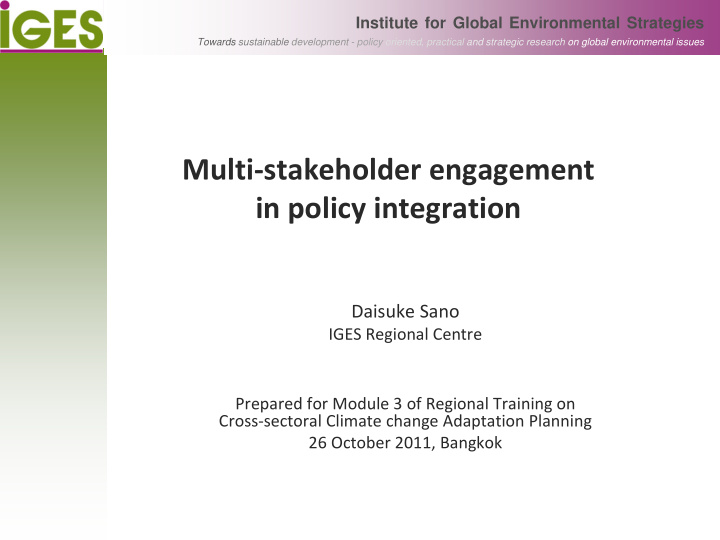



Institute for Global Environmental Strategies Towards sustainable development - policy oriented, practical and strategic research on global environmental issues Multi-stakeholder engagement in policy integration Daisuke Sano IGES Regional Centre Prepared for Module 3 of Regional Training on Cross-sectoral Climate change Adaptation Planning 26 October 2011, Bangkok
Scope • Role and importance of multi-stakeholder participation in policy integration • Various forms of multi-stakeholder engagement for policy integration • Some overlaps but examined from different angles Module 3 Pillars of effective cross-sector approach to adaptation strategy Science-policy nexus (science community, governments) Integrative administration and capacity building Multi-stakeholder (governments) engagement (and other stakeholders) 2
Outline • An overview of multi-stakeholder engagement • Climate adaptation and its challenges • Challenges of multi-stakeholder approach • Possible responses to challenges 3
Multi-stakeholder engagement • Why? • Participatory process to make robust decision • Democratic process to have minority’s voices heard • Examine the issue from various point of views • Sense of ownership of the issue, etc. • Who are the stakeholders in cross-sectoral adaptation planning? • Multiple sectors: already multi-stakeholder (horizontal) • Along the decision-making process (vertical) • Public sector, private sector, academia, NGOs, media, general public • Supporting/ development agencies, networks/initiatives (external) • It also could be across generations (temporal) • Who should be leading the multi-stakeholder engagement in adaptation planning? 4
Climate change adaptation • A pair of wheels with mitigation • Lower cost for early response and successful mitigation action • Inseparable - co-benefits/win-win options • An essential component of sustainable development • Needs cross-sectoral (horizontal) and multi-stakeholder along the decision-making (vertical) approach • Should fit into green economy, green growth, etc. • Should become a norm to “have development done right“ • Not old, but not all new, either • Disaster management, crop variety development, etc. • Indigenous knowledge • Aim to address possible incremental impacts from climate change 5
Challenges 1: Technical capacity • Limitation in climate change forecasts • Accuracy of the short-/long-term forecasts by global models • Difficulties in down-scaling and inclusion of micro-climate conditions • Limitation in assessment methodologies • Appropriate indicators for economic, environmental, social impacts • Lack of appropriate indicators (a single proxy, compound) to evaluate resiliency, adaptive capacity, the effectiveness of adaptive measures, etc. • Limitation in availability and quality of data • Absence of data, insufficient observation points, lack of standardized data collecting methods, etc. 6
Challenges 2: Institutional capacity • Capacity in climate change forecasts, vulnerability/impacts assessment • National agencies, research institutes, universities • Governance in strategy development, policy making • Awareness • Insufficient capacity/mandate of office in charge • Poor inter-governmental coordination (cross-sectoral), sectionalism ⇒ Establishment of national climate council, etc. • Immature democratic/ not-so-transparent decision-making, conflicts of interests, corruption, vested rights, rent-seeking behavior, etc. • Capacity to identify gaps in adaptation measures and assistance needs, to prioritize issues 7
Challenges 2: Institutional capacity (cont’d) • Capacity in project implementation, project formulation, accessing/managing fund • Lack of experience or aid fatigue/ too much dependency on aid agencies • Difficulties in policy making under dynamic circumstances • Rapid development in emerging economies • Longer-term planning/inter-generations planning • Lack of common ground for international climate change discussion • Free riders 8
Mainstreaming of adaptation in Japan A lot more emphasis on mitigation Comparison of entry of key words between MAFF and MOE Ministry of Environment Ministry of Agriculture GHG Mitigation* Adaptation** GHG Mitigation* Adaptation** 2004 30 10 0 1 1 0 2008 78 114 13 1 1 0 2009 86 197 14 31 54 7 Based on the each ministry’s annual white paper (relevant chapters only) *: Only those related to CO2/GHG were counted **: Only those appear in the context of climate change were counted Note: There is a tendency that each ministry tries to reduce the description of the other ministries when reviewed (sectionalism). 9
Challenges 3: Resources • Financial base • Insufficient national budget • Lack of access to external fund • Human capital • Insufficient institutional capacity for policy/decision making (Challenges 2) ⇒ inappropriate resource allocation/management, issue prioritization • Insufficient institutional capacity to develop knowledge base • Knowledge base • Insufficient knowledge generation • Lack of clearing house of existing lessons and good practices • Insufficient exposure to new knowledge • Investigation of emerging issues and new problems 10
Challenges of multi-stakeholder approach (summary) • Finding a common ground/vision • Conflicts of interests among many stakeholders (present as well as future time) • Incorporation of the public comments, extreme views, voices of the minority, etc. and/or lack of such procedures • Most likely no pareto optimal solution (losers & gainers) • Lack or insufficient mandate in office in charge (topic in the next session) >>> one of the critical points in climate change • Lack of application of decision-making tools • Incorporation of more knowledge-intensive and/or cross-sectoral information into policy making (topic in the previous session) • Insufficient incorporation of adaptation component in existing approach and framework 11
Possible responses to challenges • Application of available tools to gain lessons • Community-based, eco-system-based, vulnerability-based adaptation, EIA, etc. • Assessment of enabling factors and/or failures • Development of supporting tools for decision-making with multiple stakeholders • Tailor of the existing tools to national/local conditions • Tools to formulate win-win/no regret options • Decision-making under uncertainties • More centralized or decentralized decision making process • Designing more adaptive policies 12
Possible responses to challenges (cont’d) • Use of available knowledge from supporting mechanisms • Adaptation-related network (APAN, AKP, etc.) • AECEN’s twinning project (south-south/north-south capacity development), etc. More broadly, • Invest on human capacity development and R&D to deal with climate change • Education for next generation • R&D that induces private sector’s involvement • Creation of green jobs • Go beyond adaptation 13
Recommend
More recommend